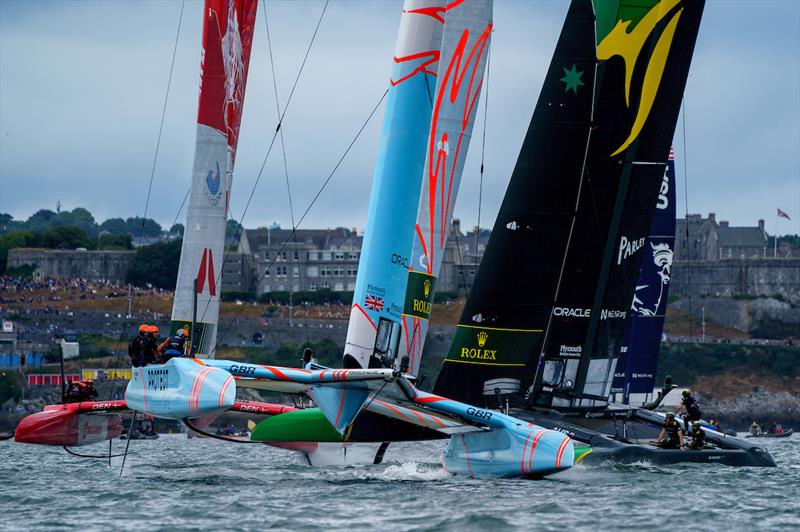
SailGP: Ainslie suggests that Chief Umpire should be "sent to the Tower"
by Tom Cary, Daily Telegraph 1 Aug 2022 05:27 PDT
1 August 2022

Great Britain SailGP Team, Denmark SailGP Team and Australia SailGP Team in action on Race Day 2 of the Great Britain Sail Grand Prix | Plymouth in Plymouth, England. 31st July . Photo: Jon Super for SailGP. Handout image supplied by SailGP © Jon Super/SailGP
A frustrated Sir Ben Ainslie hit out at chief umpire Craig Mitchell after Great Britain were controversially denied a spot in the final three-boat sail-off at SailGP Plymouth on Sunday. Ainslie suggested, only half-jokingly, that the watching Duchess of Cambridge should “send him to the Tower”.
The four-time Olympic champion was angered by Mitchell’s call to penalise Great Britain after a tight cross with Australia right at the end of the final fleet race. Australia had right of way and Mitchell, a British umpire, decreed Australia’s helm Tom Slingsby had had to take evasive action to avoid a potential collision.
Ainslie insisted that Slingsby had in fact pulled a “Hollywood”; a term used to describe a manoeuvre designed to make something look worse than it is in an effort to sway the umpire.
“It was tight,” Ainslie admitted in a television interview immediately after the race. “The big question in the umpire’s mind will be the ghost boat [the simulator tool umpires use to predict boats’ positions in three boat length’s time].
“Obviously I don’t agree with the decision. It’s not the first time I haven't agreed with Craig Mitchell and it won’t be the last.”
Ainslie was referring in particular to the Danish round of SailGP last year when he was furious with Mitchell’s call to penalise Great Britain in the final.
The penalty meant Great Britain had to drop behind Australia on the line, finishing fourth in the race rather than third. The loss of that place meant Ainslie’s team finished level with Denmark on points, the Danes advancing to the final by virtue of the fact they finished the final fleet race in second place. Denmark went on to finish the regatta in third place behind New Zealand and Australia.
'It was a pivotal moment in the final race'
After returning to the dock and reviewing the footage, Ainslie said he was even more convinced that Great Britain had been wronged, adding that he was “getting pretty annoyed” with Mitchell’s calls.
“I’ve had a look at a replay and I have to say, yeah, it’s a bad call,” he told Telegraph Sport. “In Denmark last year we had a similar incident which we thought was pretty clear cut. It was a pivotal moment in the final race.
“I mean it's a tough job umpiring. And some might say ‘Well you shouldn’t leave it in the hands of an umpire’. But at that point we had to cross to get to the finish line.”
Ainslie said the issue with the predictive “ghost boat” software was that it did not take accelerations or decelerations into account, with Britain still accelerating out of a gybe when they crossed.
He added that it might be time to bring in some sort of review or protest mechanism for tight calls, rather than decide everything in real time. “That's something we’ve really steered away from because traditionally in sailing, you’d get protest hearings which went on for hours and hours. But I think maybe we should because it’s getting pretty serious. It’s high stakes now.”
Ainslie added: “I’m actually getting more and more irritated because I try to defend umpires. It’s a difficult job. But in my opinion it was 50-50 at worst. And if it’s 50-50 then it should be a green flag because the umpires shouldn’t be deciding the outcome of the race. He [Mitchell] does have a tendency to want to decide the outcome of a race in my experience.”
For the full story and Ainslie's thoughts on a difficult Day 1, where the Brits were involved in a pre-start collision with the Spanish entry click here
The finish line incident viewed from onboard cameras
(N.B. The effect of the camera lens shooting end-on in Images 1, 2, 3 and to some extent in 4, is to give the distorted impression of distances being shorter than is actually the situation. Images 5 and 6 give a better indication of distance between the two F50's.)